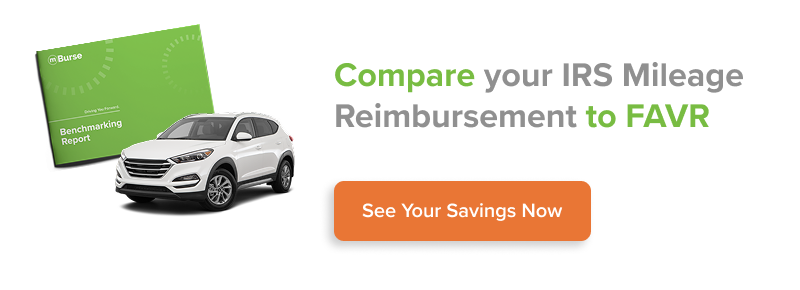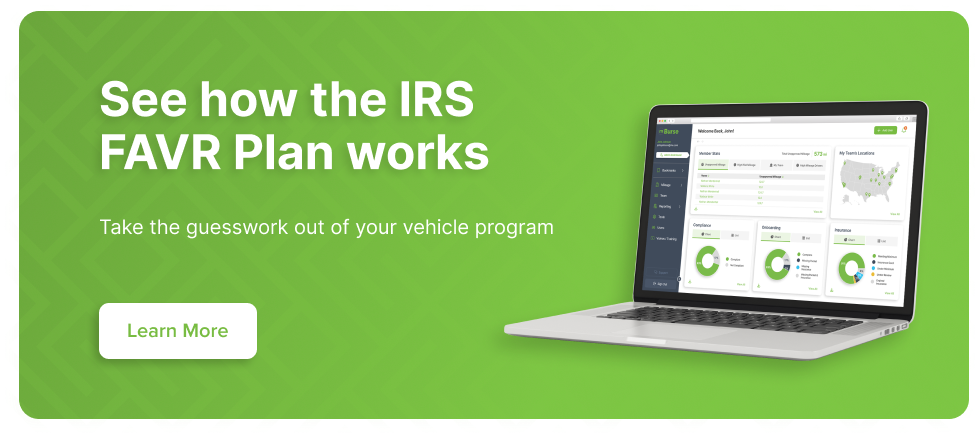The IRS fixed and variable rate (FAVR) program reimburses employee vehicle expenses accurately and tax-free. Using localized data to calculate payments, FAVR is more precise and transparent than mileage reimbursements and car allowances.
At mBurse we promote fixed and variable rate reimbursement (FAVR) as the preferred way to pay for employee vehicle expenses. The following Q & A answers common questions about FAVR vehicle reimbursement programs.
What is a FAVR program?
A FAVR reimbursement plan combines a fixed monthly car allowance with a variable mileage rate, both paid tax-free. The IRS has recognized FAVR as an accountable vehicle reimbursement procedure since 1992.
FAVR program vs. car allowance
A FAVR vehicle plan differs from a traditional car allowance in two important ways:
- All payments are non-taxable.
- Rates vary based on localized expense data.
FAVR vs. cents-per-mile program
A FAVR reimbursement plan also differs from a standard mileage reimbursement. Rather than paying a one-size-fits-all mileage rate like the IRS rate, a FAVR plan pays each driver's expected costs. Localized cost data determine FAVR rates. This makes sense because expenses vary greatly by region and by how much an employee drives.
Why is FAVR tax-free?
The IRS in Publication 463 categorizes fixed and variable rate as a federal accountable plan. FAVR was specifically designed for corporations to use for accurate reimbursement of employees. These payments are tax-free because the company can prove that the payments match the vehicle expenses.
Mileage reimbursement at the IRS federal rate or less is also tax-free. However, because the IRS mileage rate was designed for tax deductions by individual taxpayers, it is less accurate than FAVR rates. A FAVR reimbursement plan is best practice because it relies on precise data, not national averages.
How does FAVR reimbursement work?
A FAVR reimbursement program has three main components:
- Rates are based on a standard vehicle
- Location-specific calculation of payments
- Separate calculation of fixed vs. variable costs
FAVR vehicle requirements
Under a FAVR vehicle plan, an organization selects a standard vehicle to generate reimbursement rates. This vehicle is designed to meet the needs of employees in carrying out their jobs, not what they actually drive.
Basing the rates on a standard business auto keeps the calculations fair. Employees may drive their vehicle of choice, but it must fit within the age requirements set by the organization. The IRS sets a maximum value each year that the vehicle cannot exceed.
[Read more: How Reimbursement Using a Standard Vehicle Works]
Location-based payments
Next, a fixed allowance and a mileage rate for each employee is calculated based on
- Their home zip code or garaging point
- The standard vehicle chosen by the company
Each employee then receives a vehicle reimbursement schedule that details all of the costs being reimbursed. These costs are broken into two major categories: fixed costs and variable costs.
Expenses FAVR covers (fixed and variable)
A typical schedule covers the following expenses:
Fixed costs
- Insurance
- Registration, taxes, fees
- Depreciation
These costs are paid by a fixed monthly allowance. Depreciation is the largest category of expense.
Variable costs
- Gas
- Oil
- Maintenance
- Tires
These costs are paid at a cents-per-mile rate that adjusts monthly to keep pace with gas prices.
What is FAVR's legal compliance?
A FAVR vehicle plan complies with all IRS rules and regulations for business reimbursements. Any organization with a properly administered FAVR program can rest assured that they will pass an audit smoothly.
FAVR rates also comply with state laws that require reimbursement of vehicle travel. This benefit is particularly important for organizations with employees operating in California, Massachusetts, and Illinois. FAVR also complies with labor laws in several other employee-friendly states.
What are the IRS requirements for FAVR?
Each year, the IRS issues a set of rules that define FAVR and delineate it as a non-taxable reimbursement procedure. The best-known rule requires businesses to have at least five employees on the FAVR plan. These employees are required to drive at least 5,000 miles per year.
The vast majority of the rules are based on data modeling. These rules cover such topics as
- Vehicle value and age
- Insurance requirements
- Annual business mileage
- Business use percentage
- Employee participation level
Some of the IRS requirements for FAVR depend on the company’s objectives. For example, if a company would like to control its image, it can use a nicer or newer vehicle to generate rates. This, in turn, would require employees to utilize nicer or newer vehicles.
How are FAVR plans administered?
Because FAVR regulations involve complex calculations and are subject to annual changes, it is best to have a third-party administrator design and manage the program. A trusted advisor who stays ahead of the rulings and has experience with administration can prove indispensable.
Switching from a traditional car allowance to a FAVR plan frees up significant financial resources by eliminating tax waste. This enables an organization to enhance employee benefits and lower overall expenses while also engaging a third-party administrator.
Similarly, switching from the IRS mileage rate frees up resources by eliminating overpayments to high-mileage employees and reducing attrition due to the underpayment of low-mileage employees.
Why choose a FAVR vehicle program?
Fixed and variable rate programs were designed to pay auto reimbursements accurately, fairly, and easily. An organization can reimburse employees exactly the same way they incur costs, based on their location and driving expenses.
FAVR reimbursement plans make sense because they will not over- or under-reimburse employees. They also
- Control company costs
- Mitigate risks (from labor codes and general liability)
- Help attract and retain talent
The company should seek a vehicle reimbursement system that is accurate for each employee while controlling costs, a task that is not easy. Remember, in some states, employees can sue for unreimbursed business expenses.
Is my company a good fit for FAVR?
A FAVR plan is a good fit for an organization with employees who drive a variety of distances and work in different locations. Switching to a FAVR reimbursement model is a cost-effective solution that can address problems associated with common models.
Whether you currently pay a car allowance or a mileage reimbursement, you will face challenging questions:
- Are you over-reimbursing or under-reimbursing?
- Are employees losing money to taxation?
- Are all employees happy with their allowance or reimbursement?
- Can you stay within budget?
- Are you violating state labor laws?
FAVR resolves these quandaries and simplifies reimbursement for employees who use their personal vehicles for business purposes. Switching to a FAVR program can be communicated in ways that highlight the benefits to all employees.
mBurse specializes in helping organizations adopt and implement FAVR programs. Find out how your organization and its employees could benefit.


